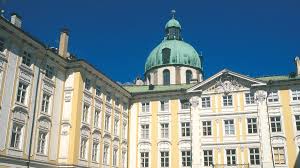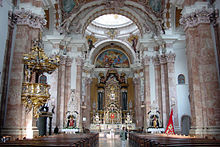As we approached Tyrol, in the heart of the Austrian Alps, I felt like yodeling. We were headed to Innsbruck and our long drive was right smack in the Alpine region.
When I was growing up in the Philippines, there was this instant milk product called “Alpine Milk” that was introduced in the market to compete with the more popular “Birch Tree Dutch Milk.” I have memories of my mom forcing me to drink "Birch Tree" milk every, single night before bedtime and I used to dread the moment. (I hated milk when I was a kid…most especially, powdered milk stirred in boiling water…the awful smell made me gag.)
I joked with my mom that we should switch to “Alpine Milk” because they had a nicer TV commercial. Their ad campaign featured a little blond boy in lederhosen, happily drinking his milk after frolicking around the hills with the cows. The milk was so delicious that he couldn't help but dance and yodel. I said to my mom, “Maybe we should buy this brand instead. Maybe it tastes better. It also seems more authentic.”
I guess at a young age, I was already aware of the merits of production value. While this commercial was probably filmed at a local hill that was styled to look like an Alpine hill, at least they did it in a real location...and with real cows! In contrast, the “Birch Tree” commercial was cheaply done in a studio with two kids, a boy and a girl, dressed in Dutch costumes, drinking milk against a background of fake windmills made out of painted wooden panels that oozed with a 70s-style sitcom vibe. Beside them was a cow puppet that gave this already-sitcom-style set a Sesame Street-like twist. Unfortunately, their bovine character was not as cute as Gladys the Cow. It did not impress six-year-old me. Besides, the Alpine boy’s “Yodoleihee-hoo!” in sing-song tone sounded more convincing than the Dutch children’s “Hmmm…it’s heerlijk (delicious)!”
My mom did buy this other brand due to insistent kiddie demand (I persuaded my brother to work with me on this one, because he, too, hated milk). But our plan backfired because we found out that “Alpine Milk” was not at all better tasting than “Birch Tree Milk.” Powdered milk, no matter what the brand, is just nasty.
Fake Alpine milk and fake Alpine cows aside, all I wanted to to say is that I truly enjoyed the drive around the real Alps...and yes, I saw real Alpine cows as well. Outside our window was a tranquil view of verdant rolling hills and story-book villages with timbered chalets that had window boxes brimming with colourful flowers. Everywhere around us were towering mountains casting their images onto turquoise lakes, verdant fields dotted with wild flowers, cows and sheep contentedly grazing, gigantic trees that almost looked like they were hugging each other, and a bit of a fog. It was magical. This was my favorite place in Europe, so far.
Our drive along the zigzag mountain roads was also quite amusing. Since we were skirting mountain ranges, our route took us from Germany to Austria, then back to Germany and then Austria again. Our Tour Director cheerfully announced where we were, each time we switched countries, as if she knew exactly where the demarcation lines were.
But even without the announcements, our cellphones gave us constant updates on which side we were at. The roaming signal would switch from the German service provider (Vodafone) to the Austrian service provider (Orange) and vice-versa. "Vodafone welcomes you to Germany,” my screen would say and then, “Orange welcomes you to Austria” and so on. It was like being in some kind of limbo where you were neither at this place or that.
We drove past Zugspitze Mountain both on the German and the Austrian side. Our Tour Director was sure to point that out. She explained that the border between Germany and Austria goes right over this mountain. In fact, there used to be a border checkpoint at the summit. Since both countries are now part of the Schengen zone, the border crossing is no longer manned. Each country, however, has its own terrace on top of the mountain, connected by a narrow walkway. A golden cross also sits on its highest point and there is a museum and a restaurant as well. It's a popular skiing and hiking spot, but unfortunately, not a part of our tour. We just admired its peaks from a distance.
When we finally reached Innsbruck, I was still awestruck. Innsbruck is the capital of the Federal State of Tyrol in western Austria. It is dubbed as the “largest ski resort in the Alps” and has twice hosted the Winter Olympic Games. It's such a charming city.
After a brief drive around, we stopped at the Wilten Basilica (Basilica of the Immaculate Conception and Our Lady of the Four Pillars), one of the most splendid churches of Tyrol and a famous pilgrimage site since the Roman times.
The present church lies on the ruins of a much older church dating back to the earliest days of Christianity, where according to oral tradition, a painting of the Madonna was venerated by Christians and Roman Legionnaires. In the 12th century, another church was built and the focus of the pilgrimage then was the sculpture of Our Lady of the Four Pillars. In time, the church became dilapidated and in the 17th century, it was replaced by the present Baroque structure.
While the exterior of the church was painted white and yellow with a buttery tone, the interior is predominantly white adorned with gold leaves in the Rococo style. The centerpiece is a high altar framed by four pillars and capped by a large crown. Beneath the marble canopy is the sandstone statue of the Virgin Mary. On the ceilings are murals depicting the life of Mary and all around are pieces created by renowned Austrian artists – statues, plaster work, paintings. What a beautiful church! And all that white made us feel we were partly in heaven! Before we left, we lit a candle and offered a prayer for our safe journey.
After checking in at our hotel, we walked from the Marie Theresien Strasse, Innsbruck's grand boulevard lined with shops, restaurants, and sidewalk cafés into the cobbled Old Town to see the nearby architectural jewels of the city.
First on the list was the famous Golden Roof, a three-story balcony on the central plaza. It was constructed for Emperor Maximilian I to serve as a royal box where he could sit in state and watch the tournaments on the square below. The roof is decorated not with gold (as its name implies), but with fire-gilded copper tiles that glinted in the sunlight like gold. The reliefs on the balcony include the royal coat of arms and an image of the emperor in between his first and second wives, Maria of Burgundy and Bianca Maria Sforza of Milan.
Next, we stopped to admire the Helblinghaus which stood out among the medieval buildings around because of its strikingly contrasting Rococo façade. It reminded me of a birthday cake's elaborate frosting.
Then we went to see the Hoftburg Imperial Palace, a beautiful Gothic-style castle, which was one of the most important homes of the Habsburgs. There was no time to take the tour inside but we were told that this contained large representation rooms, a chapel, a state-of-the-art heated banquet hall, a chancellery, a living room with large windows, a winding staircase, elaborate wall coverings, and a stretch bed.
Nearby was the Hofkirche (Imperial Church), a Gothic church built by Emperor Ferdinand I as a memorial to his grandfather, Emperor Maximilian I. It contains the ornate black marble cenotaph (empty tomb) of Maximilian I surrounded by 28 larger-than-life bronze statues of ancestors, relatives, and heroes. This was my favourite feature of the church. Looking at them made it easy for me to imagine all these royal people paying homage to their king in a bygone era. The tomb is actually empty because it wasn't completed until 100 years after Maximilian's death. By then, nobody wanted to remove his remains anymore from where it is resting, some 500 kilometers away outside Vienna. Who would want to bother with that, I agree. After all, the same level of honour has already been accorded to him for decades.
Our Tour Director booked us a tour of the Swarovski Crystal Museum (Swarovski Kristallwelten), one of the oldest Swarovski shops in Europe in one of the oldest buildings in Innsbruck. This is an Innsbruck must-visit, according to her. After a short introduction by the host about the company and their products, we were free to roam around.
At the time of our visit, they had something like a “Winter Wonderland” subterranean exhibition made up of 14 different chambers, where the displays showed endless creative possibilities with crystals. It was a beautiful showcase with a bit of a magical element, but it did not impress me much. It was more like an ingenious marketing concept that combined art, technology, and modern design. At the very end, we were given little tokens of gratitude (a small decorative crystal piece) and discount coupons. The sales manager also told us about the special offer for that afternoon. While some of my tour mates commenced their crystal shopping, my husband and I headed out to the opposite end of the Old Town.
We came across the Innsbruck Cathedral, also known as the Cathedral of St. James, where the painting of Maria Hilf (Mary of Succor) is displayed above the main altar. It is said to be among the most venerated Marian images in Christendom. The church also houses the tomb of Maximilian III, Grand Master of the Teutonic Knights. Here, we also prayed and lit candles.
Right outside the church, we saw a gelato house. We decided to take a break from sightseeing. My husband ate his take-along sandwich, while I enjoyed my raspberry gelato. We hung out at one of those umbrella-covered patio tables in the centre of the square and quietly stared at the city panorama before us – a long pedestrian street lined with old buildings set against a backdrop of magnificent mountains traversed by throngs of people doing their shopping or just chilling out.
It was nearly dusk, so the view of the setting sun with its changing hues of red, orange, and yellow, and all shades of purple was a bonus. After our brief respite, we purchased some souvenirs and some fresh fruits from the market and then headed to our hotel for dinner.
Photo Credits:
Ingo Schwanitz, Octagon (Wikipedia), continentshop.com, tripsite.com, austria.info, Luca e Elena (Trip Advisor), tirol.at, Gerlinde (Trip Advisor), kristallwelten.swarovski.com, sandwirt.com, earthtrekkers.com, oneman-onemap.com

































































































Kommentare